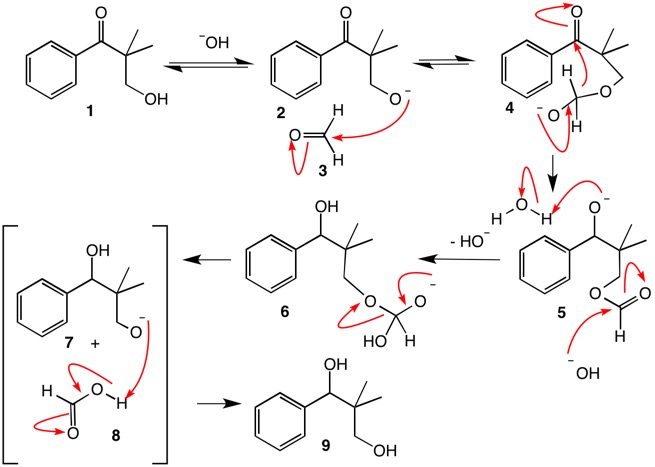According to answer key, Cannizzaro reaction of 3-hydroxy-2,2-dimethyl-1-phenylpropan-1-one (a ketone) takes place but how is that possible when we know only aldehydes show Cannizzaro reaction?
1 Answer
There are a number of discussions on this site regarding the Cannizzaro reaction. In strong base there are competing reactions (aldol self-condensation) that can occur with ketones that have at least two hydrogens vicinal (next to) the ketone. Even aldehydes suffer the same fate. That is why the aldehydes are usually aromatic. But I believe in this case reduction may well be facilitated by an intramolecular hydride transfer. Intramolecular reactions are, as a rule, faster than intermolecular reactions owing to the high concentration of the reacting species. The keto alcohol 1 forms alkoxide 2 which reversibly adds to formaldehyde. Intramolecular hydride transfer occurs in intermediate 4. The formate group is saponified (5 ---> 7) forming the diol 9 and sodium formate 8. The deprotonation 7 ---> 8 should not be taken literally. Base and water intercede. Just saving space. See transition state for reduction below reaction mechanism.


-
$\begingroup$ So just to be more clear you're saying it's not following Cannizzaro but an intramolecular hydride shift, which happens to behave exactly like Cannizzaro and give the same product. $\endgroup$ Commented Nov 30, 2017 at 2:55
-
$\begingroup$ But the Cannizzaro reduction does involve a hydride addition to an aldehyde as you are used to studying it. To argue why this aromatic ketone reduces, a special mechanism is required. As a control experiment, I expect that tert-butylphenyl ketone (replace hydroxyl group with hydrogen) would not reduce or certainly not as fast. The hydroxyl group helps to deliver hydride by attaching formaldehyde. Ketone ---> secondary alcohol is a 2-electron reduction. Formaldehyde ---> formate is a 2-electron oxidation. The Cannizzaro reaction is a redox reaction. $\endgroup$ Commented Nov 30, 2017 at 3:17
-
$\begingroup$ To sum it up exception of a ketone showing Cannizzaro because of the conditions, right? $\endgroup$ Commented Nov 30, 2017 at 3:39
-
-
$\begingroup$ In the 5th step, isn't the partial positive charge on the carbon of the ester-like system significantly reduced?(where the attack of OH- has been depicted) So would an attack by OH- be feasible there, or is it just due to the concentration of OH-? $\endgroup$ Commented Jan 1, 2019 at 12:48

